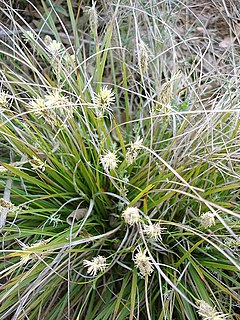
The Cyperaceae are a family of graminoid (grass-like), monocotyledonous flowering plants known as sedges. The family is large, with some 5,500 known species described in about 90 genera, the largest being the "true sedges" genus Carex with over 2,000 species.

Carex is a vast genus of more than 2,000 species of grass-like plants in the family Cyperaceae, commonly known as sedges. Other members of the family Cyperaceae are also called sedges, however those of genus Carex may be called true sedges, and it is the most species-rich genus in the family. The study of Carex is known as caricology.

Uncinia is a genus of flowering plants in the family Cyperaceae, known as hook-sedges in Australia and as hook grasses or bastard grasses in New Zealand. The genus is characterised by the presence of a long hook formed by an extension of the rachilla, which is used to attach the fruit to passing animals (epizoochory), especially birds, and it is this feature which gives the genus its name, from the Latin uncinus, meaning a hook or barb.

Carex chordorrhiza, commonly called creeping sedge or string sedge, is a species of perennial plant in the family Cyperaceae with Holarctic distribution growing in acidic bogs.

Carex canescens L. is a perennial species of plants in the family Cyperaceae growing in damp forests and wetlands. It is widespread across much of Europe, Asia, Australia, New Guinea, North America, Greenland and southern South America.

Carex rostrata, the bottle sedge or beaked sedge, is a perennial species of sedge in the family Cyperaceae.

In botany, a perigynium, also referred to as a utricle, typically refers to a sac that surrounds the achene of plants in the genus Carex (Cyperaceae). The perigynium is a modified prophyll, tissue of leaf origin, that encloses the dry, one-seeded achene.

Carex sect. Spirostachyae is a section of the genus Carex, containing 38 species of sedge. Species in Carex sect. Spirostachyae share a suite of features, including the short internodes of the primary rhizomes, the presence of an antiligule, the leaf-like, sheathing bract at the base of the inflorescence, the presence of three stigmas in female flowers, and the shape of the seeds.

Carex subg. Carex is a subgenus of the sedge genus Carex. It is the largest of the four traditionally recognised subgenera, containing around 1400 of the 2000 species in the genus. Its members are characterised by the presence of one or more exclusively male (staminate) terminal spikes, quite dissimilar in appearance from the lateral female (pistillate) spikes below. In most species, the female flowers have three stigmas, but a few species, including Carex nigra, have female flowers with only two stigmas.
Carex acaulis, known as the small dusky sedge, is a species of sedge in the genus Carex native to the Falkland Islands and southern Argentina.

Carex subg. Vignea is a subgenus of the sedge genus Carex, containing around 300 of the 2000 species in the genus. Its members are characterised by having bisexual, sessile spikes, where the female flowers have two stigmas each.

Carex kobomugi is a species of sedge, known as the Japanese sedge or Asiatic sand sedge, that lives in sandy coastal areas of eastern Asia, and has become an invasive species in the north-eastern United States.

Carex viridula, known as little green sedge, green sedge, or greenish sedge, is a small flowering plant native to North America, Europe, Asia, and Morocco.

Carex erebus is a member of the sedge family and is found on the Antarctic Islands of Australia and New Zealand.
Peter William Ball is an English-born botanist, plant collector, and plant taxonomist, specializing in caricology.

Carex remota, the remote sedge, is a species in the genus Carex, native to Europe, the Atlas Mountains in Africa, and western Asia. It is a riparian forest specialist. It is known as one of the most frequently hybridizing species of Carex, forming hybrids with C. appropinquata, C. arenaria, C. brizoides, C. canescens, C. divulsa, C. echinata, C. elongata, C. otrubae, C. ovalis, C. paniculata, and C. spicata.

Carex divulsa, the grey sedge, is a species of flowering plant in the genus Carex, native to Macaronesia, Europe, northwest Africa, the Caucasus region, and the Middle East as far east as Turkmenistan. It has been introduced to northeast Argentina, the District of Columbia and Pennsylvania in the United States, Ontario in Canada, the North Island of New Zealand, and Tasmania and Victoria in Australia. It is the namesake of the Carex divulsa aggregate.

Carex dolichostachya is a species of flowering plant in the sedge genus Carex, family Cyperaceae. It is native to eastern Asia; central and southeast China, Taiwan, the Philippines, Korea, the Ryukyu Islands, and Japan. Its popular cultivar 'Kaga-nishiki' is sold in the US by the trade designation Gold Fountains.

Carex hispida is a species of perennial herb in the family Cyperaceae (sedges). They have a self-supporting growth form and have simple, broad leaves.
Carex paui is a rare species of sedge, with a western Mediterranean distribution; Morocco, Algeria, Tunisia, Spain,, and Italy. Some authorities considered it a synonym of Carex laxula, but as that name was not validly published, Carex paui was the next available name.


















